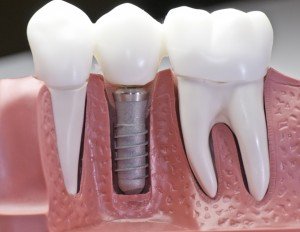 Dental implants are permanent replacements for your missing teeth. However, they can at times suffer trauma just like your natural teeth. In addition, complications can develop during the healing process that will cause your implants to become loose. If you have any problems with your implants, you should see your implant dentist right away.
Dental implants are permanent replacements for your missing teeth. However, they can at times suffer trauma just like your natural teeth. In addition, complications can develop during the healing process that will cause your implants to become loose. If you have any problems with your implants, you should see your implant dentist right away.
Dental implants consist of two parts—the root portion, which is implanted directly in the jawbone, and the visible portion, or the prosthetic teeth. The root portion includes a post on which the prosthetic teeth are secured. The success of the implant depends entirely on the bond that forms between the titanium root and the jawbone. Bone will automatically bond with titanium through a process called osseointegration. Dental implants are made in a way that encourages this process. The implants are created with many rough edges, providing a large surface area for the bone to bond with.
The prosthetic teeth, or the visible portion of the implants, are placed on the root portion after the bonding process is complete.
Implants can be jarred loose in the same way your natural teeth can. For example, if you fall on your face or are struck in the mouth, your prosthetic teeth might become loose on the posts embedded in your jawbone. If your teeth are loose simply because the prosthetic teeth have been struck or jarred, they can easily be removed and replaced so that they are secure again.
If the implant itself is loose—that is, the root portion of the implant, which is embedded in your jawbone—this could indicate a more serious issue. It is possible that the jawbone has failed to create the necessary bond with the titanium root. This bond is vital to the long-term success of the implant. If your implants become loose in the jawbone, you should see your implant dentist at Center for Oral Surgery of Las Vegas as soon as possible. You will probably need to have additional surgery to address the root cause of the problem.